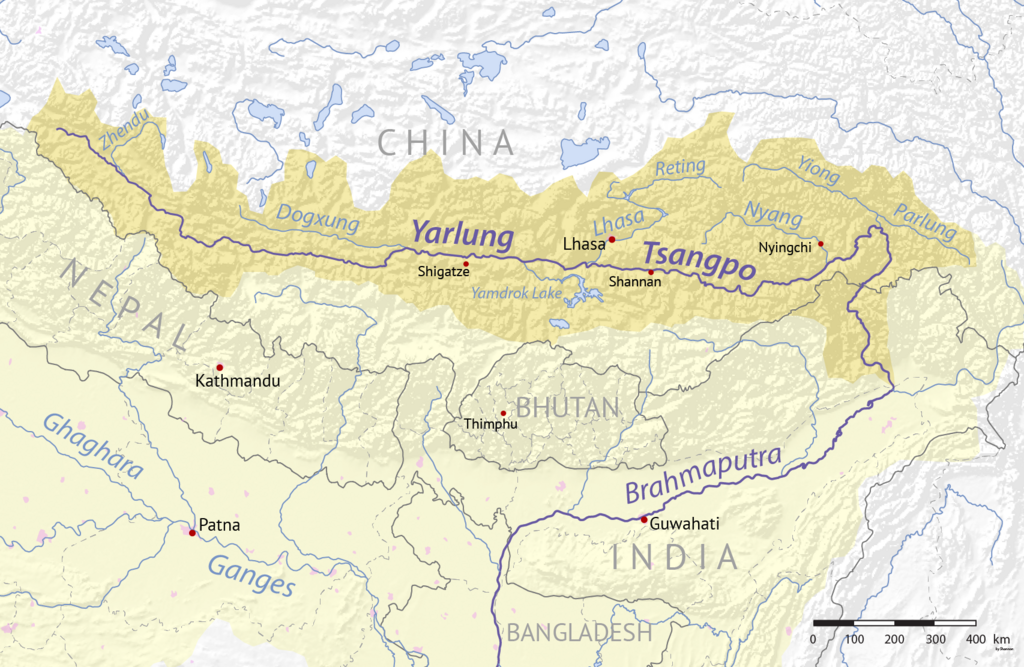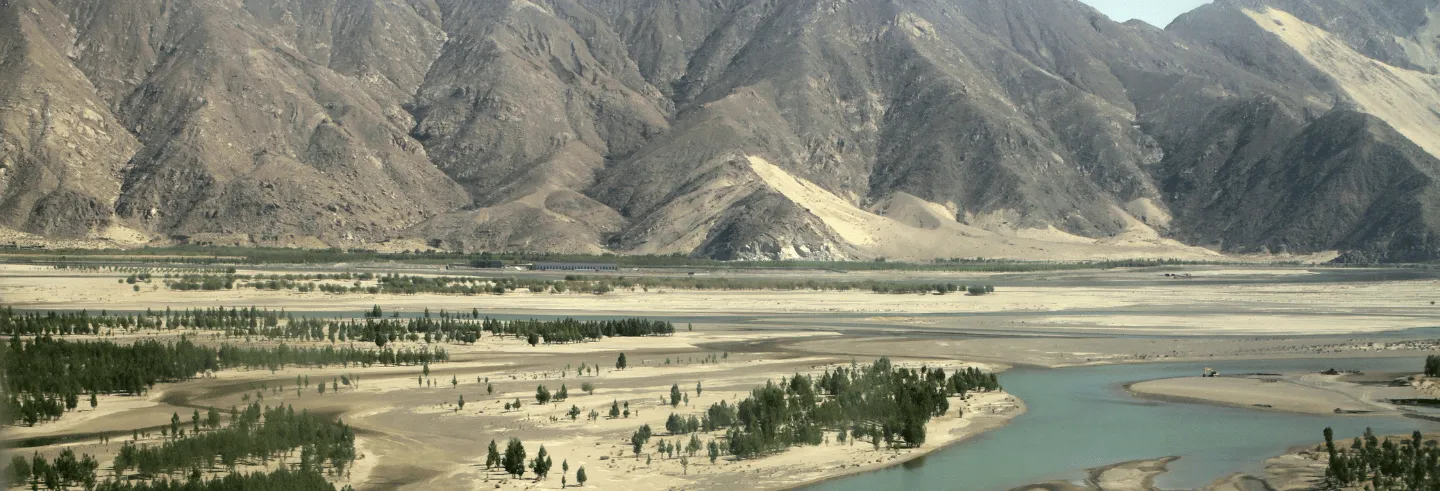China’s decision in December to greenlight the construction of the world’s largest dam on the Yarlung Tsangpo River, also known as the Brahmaputra in India and Jamuna in Bangladesh, marks a monumental development in global hydropower infrastructure. This ambitious project, the Medog Hydropower station, is set to redefine the scale of renewable energy generation, bolster China’s climate goals and reshape the geopolitics of transboundary water resources in South Asia. Yet, its implications extend far beyond its engineering marvels, as it poses both opportunities and challenges for regional stability and cooperation.
The Medog Dam, located in the remote and rugged Tibetan Plateau, is designed to harness the immense hydropower potential of the river, which descends sharply as it flows through the world’s deepest gorge. This dam is designed to generate an enormous 300 billion kilowatt-hours of electricity annually, making it three times more powerful than the Three Gorges Dam, currently the largest in the world.
Situated near the Great Bend of the Yarlung Tsangpo, the dam capitalises on the river’s natural drop of over 2,000 metres within a short stretch, providing unparalleled energy-generation potential. With an estimated cost exceeding $137 billion, the dam will be the most expensive infrastructure project globally, reflecting China’s commitment to renewable energy. The project aligns with China’s pledge to achieve carbon neutrality by 2060, as it will significantly reduce reliance on coal-based power.
The Medog Dam’s benefits are undeniable, particularly in the context of renewable energy and climate change. The electricity generated by the dam can power millions of households and industries, contributing to China’s economic growth while reducing greenhouse gas emissions. The project is expected to create jobs, stimulate technological innovation, and enhance infrastructure in the Tibetan region.
By regulating the river’s flow, the dam can potentially mitigate flooding downstream, a recurring issue that affects millions annually. The project cements China’s position as the global leader in renewable energy and large-scale infrastructure development.
Despite its impressive benefits, the Medog Dam raises several concerns, especially for downstream nations such as India and Bangladesh. India’s External Affairs Ministry has already conveyed its concerns to Beijing, urging China to ensure that the interests of downstream nations are not harmed. New Delhi has also lodged protests over China’s administrative decisions in disputed border regions, highlighting the broader tensions between the two nations.

The dam grants China significant control over the Brahmaputra’s flow, potentially affecting water availability for downstream countries, which rely heavily on the river for agriculture, drinking water, and energy. The construction and operation of the dam could disrupt local ecosystems, affecting biodiversity, sediment transport, and fish migration.
China’s unilateral decision to build the dam without consulting downstream nations violates principles of equitable water sharing, escalating tensions in an already volatile region. The dam’s location in a seismically active zone heightens the risk of structural failure, which could have catastrophic consequences for communities and countries downstream. Altered water flows can adversely affect millions of people in India and Bangladesh who depend on the Brahmaputra for agriculture and fishing.
China’s Medog Dam project presents a dual-edged sword for South Asia. While it showcases the potential of renewable energy, it also underscores the urgent need for cooperative transboundary water governance. For India and its neighbours, the path forward involves engaging China through diplomatic channels to establish a framework for data sharing and joint water management, emphasising mutual benefits and ecological preservation. Sub-basin cooperation within the Ganges-Brahmaputra-Meghna basin is essential. India, Bangladesh, Bhutan and Nepal must work together to develop a unified stance, leveraging their shared interests to negotiate effectively with China.
While China’s status as an upper riparian gives it significant leverage, India can advocate for data-sharing agreements under international frameworks...
By fostering trust and transparency through hydrological data sharing and joint monitoring mechanisms, the Ganges-Brahmaputra-Meghna nations can build confidence among themselves and strengthen their collective bargaining power. Highlighting the potential socio-economic and ecological impacts of the dam at global forums can attract international support and pressure China to adopt more inclusive water governance practices.
India’s strategic response to this development hinges on creating and leading a robust water cooperative framework within the Ganges-Brahmaputra-Meghna basin. Such a framework should emphasise sub-basin cooperation and leverage the shared interests of Bangladesh, Bhutan and Nepal. This approach would not only mitigate the risks posed by China’s dam but also unlock significant economic and ecological benefits for the region.
The Ganges-Brahmaputra-Meghna basin is one of the most densely populated and water-rich regions globally, yet it faces challenges like frequent flooding, seasonal droughts, and declining water quality. Collaborative management of this basin could address these challenges and transform them into opportunities.
In 2022, together with Sajid Karim, I prepared a report for Oxfam that calculated enhanced cooperation among Ganges-Brahmaputra-Meghna countries could save the region at least $14.2 billion annually through improved flood management, agricultural efficiency and disaster resilience.
By leveraging such insights, India can spearhead initiatives that demonstrate the tangible benefits of regional water cooperation. These initiatives should include joint flood forecasting, sustainable irrigation practices, and shared investments in water infrastructure. Transparency and trust are critical.
For India, this development is a wake-up call to strengthen regional water cooperation and engage proactively with China...
India must take the lead in sharing hydrological data with its neighbours and encouraging reciprocal actions. Establishing joint monitoring mechanisms for the Brahmaputra River, involving all riparian nations, could serve as a confidence-building measure. Transparency also extends to engaging with China. While China’s status as an upper riparian gives it significant leverage, India can advocate for data-sharing agreements under international frameworks, such as the United Nations Watercourses Convention. Although China is not a signatory, aligning with international norms can strengthen India’s diplomatic position.
The Medog Dam symbolises both the promise and peril of large-scale hydropower projects. While it can significantly advance China’s climate goals, its far-reaching implications for downstream nations cannot be ignored. For India, this development is a wake-up call to strengthen regional water cooperation and engage proactively with China to ensure the sustainable and equitable use of shared water resources. By fostering trust, transparency, and regional collaboration, India can turn this challenge into an opportunity, ensuring that the Brahmaputra River remains a source of life and prosperity for all.
China’s decision to proceed with the dam project is a stark reminder of the critical importance of transboundary water governance. For India, this development should serve as a catalyst to strengthen regional cooperation within the Ganges-Brahmaputra-Meghna basin. The road ahead will require political will, diplomatic finesse, and a commitment to sustainable peace and development.
Ashok Swain is a professor of peace and conflict research at Uppsala University, Sweden.
This article was first published in Scroll.in and is republished here with permission










